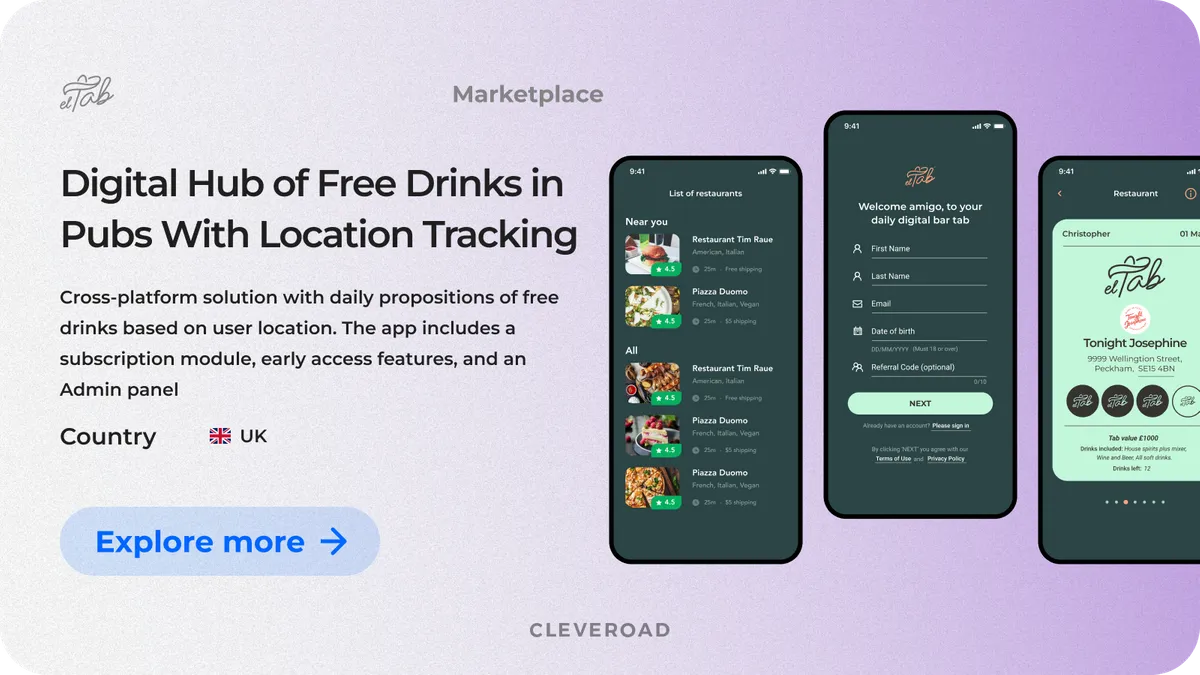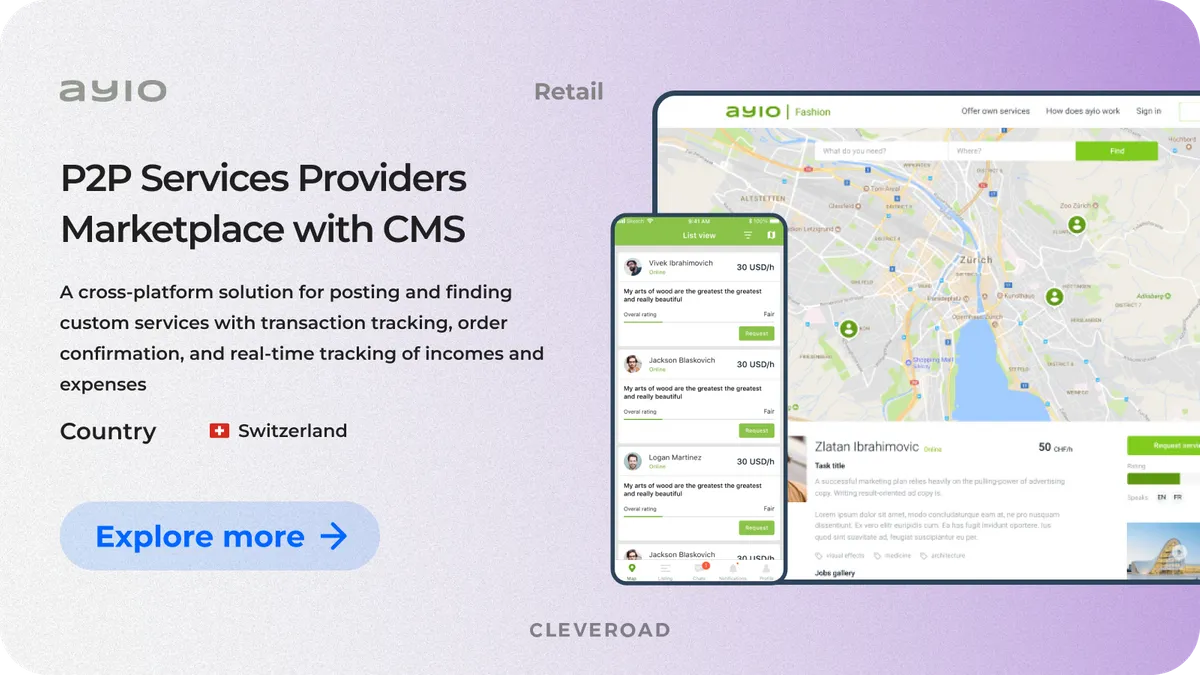How to Build a Marketplace Website in 2025: In-Depth Guide
Updated 25 Jul 2025
24 Min
9830 Views
Wonder how to start an online marketplace website that actually works? Good news: you don’t need to own products to launch one. Instead, you can build the platform that powers seamless buying, selling, or service delivery, acting as a connector between providers and buyers.
At Cleveroad, we’ve spent over 13 years delivering custom marketplace platforms, from early MVPs for startup founders to modernizing and scaling enterprise-grade sales aggregators. Based on our hands-on experience, we’ve created a practical guide to walk you through every key step: from product planning and feature scope to vendor selection, costs, and post-launch success levers.
In this guide you'll learn:
- A proven 10-step roadmap to launching your online marketplace, from niche discovery and MVP definition to post-release optimization
- How to structure your marketplace MVP with must-have features like seller dashboards, secure payments, and user messaging, and when to scale
- How to choose a tech partner that ensures fast time-to-market, domain-specific consulting, and full compliance with security standards
- A breakdown of marketplace development costs, including real budgeting examples and how to reduce risks through Discovery Phase
- The top risks founders face, like user churn, tech complexity, and legal compliance, and how to mitigate them through smart planning and the right vendor collaboration
What Is an Online Marketplace?
A web marketplace is an online platform connecting buyers and sellers and allowing them to engage in transactions for goods or services. These platforms (e.g., Amazon, Alibaba, etc.) serve as intermediaries, providing a space where multiple vendors can list their products for sale.
Before we start viewing the process of building online marketplaces, let’s find out how it works. As a rule, the operating mechanism of a marketplace includes two account levels: for sellers and buyers. Sellers create product listings, manage inventory, and set prices through their vendor dashboards, gaining access to a ready-to-buy audience without needing to build their own store. Buyers browse these listings, comparing options before making a purchase.
The marketplace typically handles payment processing, ensuring transactions are secure and efficient. Once a purchase is made, the seller is responsible for shipping the product to the buyer. Many web marketplaces also offer additional services, such as customer support, return management, and advertising opportunities for sellers. The platform usually earns revenue through listing fees, transaction fees, or a percentage of each sale.
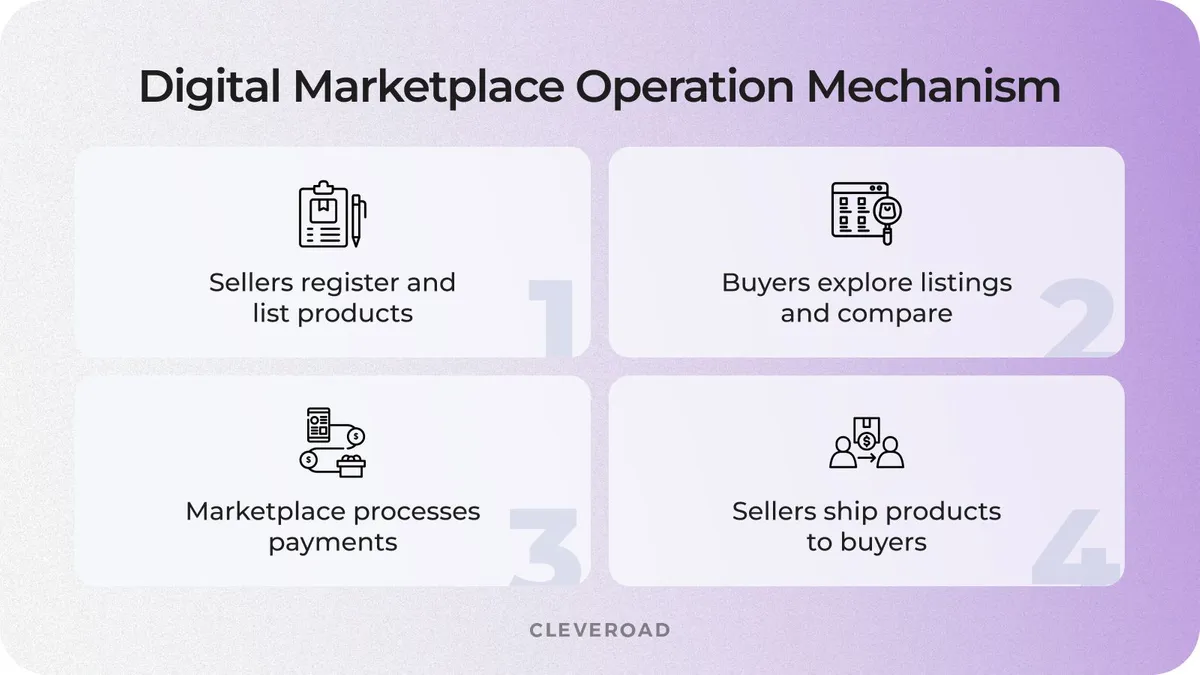
Operating mechanism of a web marketplace in a nutshell
Now when you discovered the operating mechanism of the online marketplaces, let's consider how the user experience differs when shopping on traditional markets, or eCommerce websites. While eCommerce sites provide a familiar and controlled environment, web marketplaces offer the advantage of extensive product comparisons, seller reviews, and the potential for discovering unique items not readily available elsewhere.
So, we can see that web marketplaces empower a diverse shopping experience with wide selection, seller competition, and unique finds, contrasting with the focused brand experience of eCommerce websites. This potential is reflected in the surging popularity of successful online marketplace, being reflected in the statistics below.
The potential of the online marketplace idea
Online shopping is one of the most widespread online activities worldwide. According to Statista, reaching $6,330 billion of revenue in 2023, the global retail e-commerce sales are forecasted to grow to $8.034 billion in 2027, with marketplaces taking a tidbit of these extra sales.
Let’s take a closer look at the online marketplace statistics gathered by LLC Buddy:
- About 79% of consumers in America shop online.
- Amazon is popular among approximately 80% of customers worldwide for its fast and free shipping
- About 80% of retail executives consider to employ intelligent automation for their businesses by 2027
- 56% of merchants prefer to sell their goods on the online marketplaces.
The given stats are only a little piece of marketplace statistical information, showing the immense potential of the online marketplace idea and proving that online marketplaces will be profitable for your business due to their popularity among both buyers and sellers.
How to Build a Marketplace Website in 10 Steps
The entire marketplace creation process we represent is focused on fast time-to-market through a launch of Minimum Viable Product (MVP) – the version of your marketplace with minimum required set of features. You can scale your MVP feature set in further iterations based on real user feedback. This approach helps validate core assumptions quickly and evolve your platform based on actual demand.
Here’s how to build a marketplace website:
- Define your niche & audience. Uncover a gap in the market by understanding your target audience's passion points and unmet needs. This ensures you build a platform with a loyal user base.
- Validate your marketplace idea. This helps validate your concept and avoid costly mistakes.
- Choose your revenue model. Select the most fitting model based on your marketplace structure and the value you offer.
- Find out a budget approach. Plan your budget carefully, considering research, development, post-release costs, and your monetization strategy.
- Choose a reputable IT vendor. Collaborate with an experienced marketplace development company to leverage their tech expertise and industry-specific knowledge for a cost-effective solution.
- Define a marketplace MVP functionality. Focus on the core features that solve your users’ primary needs, such as product listings, user accounts, secure payments, and messaging.
- Think out the UI/UX design. Prioritize a user-friendly interface with clear navigation and an attractive design to ensure a seamless user experience.
- Develop your web marketplace. Develop a marketplace version with core features like reviews, payments, communication channels, and secure user authentication.
- Test and refine your marketplace. QA engineers will thoroughly test your platform to identify and fix bugs before launch.
- Launch your online marketplace. Deploy your platform to a live environment, ensure all systems run smoothly, and begin attracting your first users.
All these stages of online marketplace development have their peculiarities and winning strategies. So keep reading, and we'll discuss them one by one.
Step 1. Define your niche & audience
To create an online marketplace that thrives, start by identifying a clear gap in the market. What products or services are underserved by existing platforms? Analyze competitor strengths and weaknesses, explore consumer behavior trends, and define the needs and frustrations of your target audience. This foundation is essential for delivering a tailored marketplace solution that attracts real business demand.
Whether you plan to launch a B2B marketplace or a niche ecommerce marketplace, aligning with a motivated user base increases your chances of building a successful marketplace business. Your niche will influence your go-to-market strategy, product positioning, and long-term marketplace revenue.
If you want to build marketplace platforms like Etsy or eBay, it’s not enough to mimic their features: you must understand what drives their success and how to adapt those principles to your specific audience. A well-defined niche backed by data and feedback will give your online marketplace platform a competitive edge from the start.
Step 2. Validate your marketplace idea
Before you start your marketplace, it’s critical to ensure your idea solves a real problem for a specific audience. A development partner can help you run lean market research and structure customer interviews for unbiased insights that clarify demand, usage frequency, market size, and external risks. This step minimizes the risk of building something users don’t want and saves time and resources in the long run.
By identifying product–market fit early, a marketplace owner can better prioritize essential marketplace features and tailor the marketplace functionality to real user expectations. This validation process is a crucial way to build a competitive product in the saturated marketplace today.
Dive deeper into the intricacies of custom e-commerce website development from the very beginning with our article!
Step 3. Choose your marketplace business model
When you build an online marketplace, choosing a business revenue model isn’t about perfection upfront: it’s about alignment. You can evolve your approach over time, but start with the online marketplace model that fits your value proposition and user behavior.
Among the common marketplace revenue streams are:
- Transaction fees: a percentage or fixed fee taken by the platform from each completed sale between buyer and seller.
- Listing fees: a charge sellers pay to publish their products or services on the marketplace, regardless of whether they sell.
- Subscription access: recurring payments from users (usually sellers) for premium features, tools, or enhanced visibility on the platform.
The right model supports scalability and keeps the monetization structure clear for sellers and buyers alike. A trusted tech vendor can guide you in selecting a profitable strategy before you launch a marketplace, ensuring your build marketplace efforts translate into long-term revenue. Whether you’re making a marketplace website for niche services or global retail, your revenue model should reflect how users perceive and interact with your platform.
Step 4. Map out your budget
It is equally important to plan the budget for custom e-commerce website development carefully. Hence, together with an IT vendor, you should pay attention to the following items:
- Preparation costs. Take into account the charge of marketplace research.
- Development costs. The cost of building a marketplace can vary depending on many factors, including the number of features and the location of the software vendor.
- Post-release costs. After building a marketplace, you will also need to spend some time and money for promotion and technical support.
- Monetization strategy. Think through exactly how your marketplace will generate revenue and how soon your costs will be recouped.
Planning your budget is an important step that will allow you to allocate your investment and achieve good financial results. If you plan also a marketplace application building, you can also get funding for app development through options like venture capital, angel investors and so on depending on the stage of your business and its specific needs.
Step 5. Partner with a reputable IT vendor
Finding a reliable software provider is essential if you need to build a scalable and secure consumer-to-consumer marketplace or a complex marketplace with specialized features. Collaborating with an experienced vendor ensures smoother delivery, access to cross-domain knowledge, and alignment with your product vision.
Look for:
- Proven portfolio in building an online marketplace
- Verified client reviews on platforms like Clutch
- Expertise in full-cycle development and consulting
- Ability to provide a dedicated team based on your business model
With the right partner, you get more than code: you get strategic input, speed to market, and confidence that your product won’t hit technical roadblocks post-release. Cleveroad is a seasoned tech partner with 13+ years of experience in marketplace software development. Our clients benefit from ready-to-go development teams, domain-specific consulting, and rapid MVP delivery to help them launch faster and smarter.
Step 6. Define a marketplace MVP functionality
When building out your marketplace MVP, focus on vital features that deliver primary buyer and seller needs. Such functionality allows for quick validation of product–market fit while retaining lean development that scales:
- Product listings and searching. Enable vendors to post products with details, prices, and images so buyers can easily filter and browse listings.
- Ratings and reviews. Build trust by enabling users to review after a transaction so that it augments transparency for potential future users.
- Payments and checkout. Implement secure payment gateways to make it easy to process payments, with card, wallet, or local payment support.
- Buyer–seller messaging. Allow users to communicate messages on the platform directly so that they can negotiate terms, clarify doubts, or confirm details.
- User registration and safe login. Offer both buyers and sellers individual accounts with password protection for managing listings, purchases, and profile data.
We guide our clients through this procedure in the Discovery Stage at Cleveroad. Our experts help to establish a distinct feature break-down list that aligns with your commercial goals so that an initial version of your marketplace is operable, safe, and set up for rapid feedback loops.
Step 7. Think out the UI/UX design
A standard marketplace lives or dies by its UX. Prioritize intuitive navigation, clean layout, and mobile-first responsiveness. A smooth user journey directly impacts conversions and retention.
Partnering with skilled designers rendering UI/UX design services ensures your platform builds user trust from day one. For a unique marketplace, your design must reflect your niche, guide behavior, and remove friction across the buyer and seller journeys.
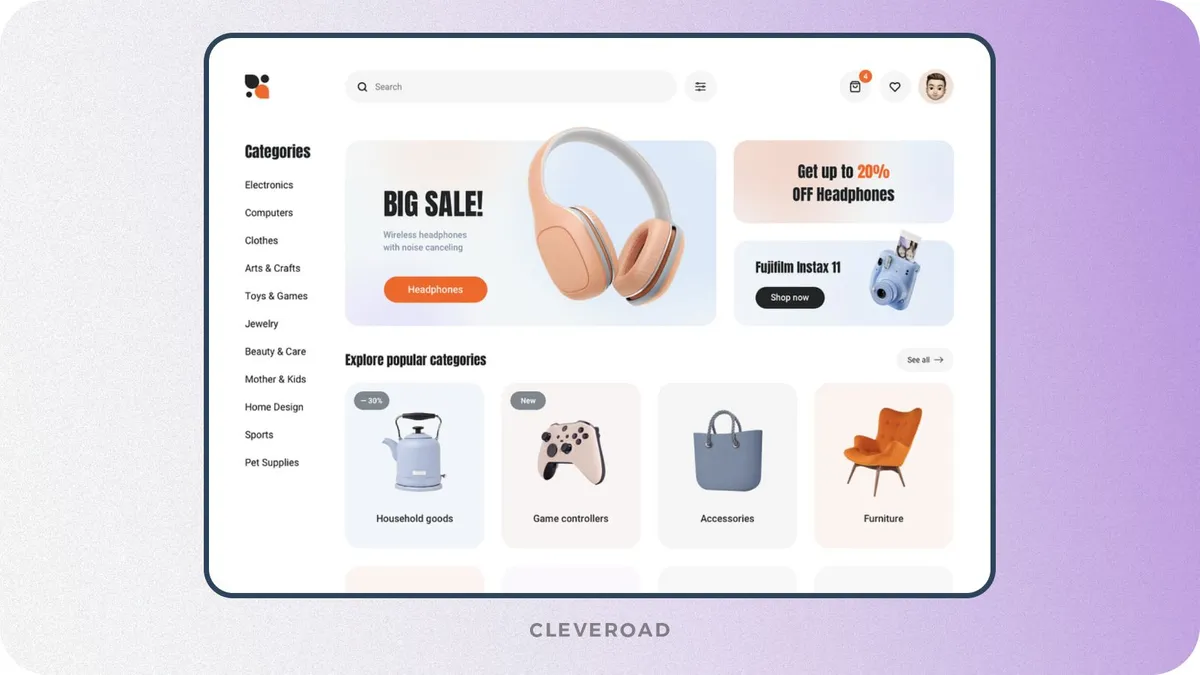
Marketplace platform design concept from Cleveroad (Source: Dribbble)
Step 8. Develop your marketplace
Start by developing a lean MVP version of your website where multiple sellers offer their goods or services. The development process typically follows Agile methodology, with features implemented in short sprints to maintain flexibility and continuous progress. Your feedback is incorporated regularly through sprint reviews, where you can assess the latest updates and adjust priorities based on evolving business needs. A skilled vendor helps you make your own marketplace website secure from the start, implementing encryption protocols and authentication.
Cleveroad helps founders build online marketplaces with solid MVPs. We follow Agile methodology and ensure your initial version includes essential marketplace features to validate product-market fit efficiently. After launch, you can expand based on real usage patterns and demand: exactly how Amazon marketplace scaled in its early days.
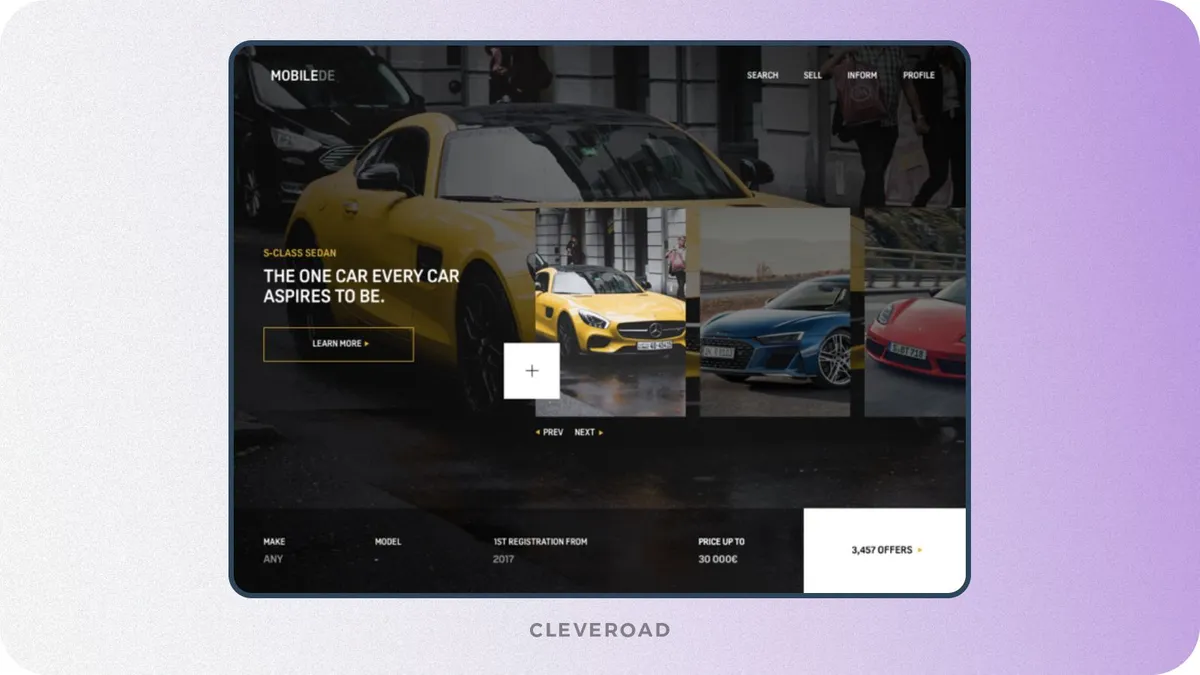
Web marketplace created by Cleveroad (Source: Dribbble)
Step 9. Test and refine your marketplace
The whole process of creating a marketplace model is accompanied by quality assurance. In addition, after the developers complete work on the project, QA engineers conduct multiple tests to ensure the software works as expected and meets your requirements. This allows them to identify and fix all possible bugs before the release.
Finally, after completing all work on setting up a marketplace website, the developers deploy it to the server and launch it. In the future, you may need to continue cooperating with your software provider to update your marketplace for better performance and scalability. Then, once your product starts generating a profit, you can reinvest it into creating additional functionality.
Step 10. Launch your online marketplace
Finally, after completing all work on setting up an online marketplace, the development team deploys the platform to a live server, ensuring it is fully configured, secure, and production-ready. This includes setting up hosting environments, optimizing loading speeds, configuring databases, and ensuring proper integrations with payment systems or analytics tools.
After launch, your collaboration with the development partner typically continues through ongoing support and maintenance. This phase includes monitoring performance, fixing emerging bugs, scaling server infrastructure to handle traffic growth, and applying regular security updates.
As user activity and revenue increase, you’ll be able to reinvest profits into adding new features or improving existing ones, such as advanced search filters, loyalty programs, AI-based product recommendations, or mobile app versions. A scalable development partner will support your evolving goals through feature roadmap planning, iterative delivery, and regular feedback loops that ensure your marketplace stays competitive and aligned with user expectations.
Post-Development Actions to Make a Marketplace Website Successful
After the development stage, you may be eager to release your project. However, it's crucial not to rush. Instead, focus on effectively launching your marketplace website and attracting your first users. Here’s a structured approach to ensure a successful start:
Attracting sellers first
To kickstart your marketplace, begin by forming a base of sellers who can offer goods or services within your unique business niche. Here are the best ways of how to find sellers when you start a marketplace website promotion:
- Reach out to sellers who are active on competitive marketplaces
- Utilize industry-specific business directories and targeted Google searches to find providers of your future goods
- Leverage LinkedIn and B2B outreach tools
Building buyer loyalty pre-launch
While attracting sellers, also work on building loyalty among potential buyers. This will help create demand once your marketplace is live. Consider these strategies:
- Pre-launch landing page. Set up a landing page that doesn't just gather emails, but offers valuable content (e.g., blog posts, industry reports) relevant to your niche. This establishes you as a thought leader and builds trust with potential buyers
- Influencer outreach. Contact influencers within your target audience who resonate with your brand and try to make them early ambassadors. Offer them exclusive access or incentives to promote your marketplace to their followers
- Run pre-launch waitlist campaigns. Create a sense of exclusivity and urgency by offering early access to users who sign up for your waitlist. Use countdown timers, gated content, or referral incentives to build momentum and validate demand before launch
Preparing for launch
With a list of interested users, you’re ready to launch your marketplace. A well-prepared pre-launch stage can give your platform an initial boost. Here’s what to focus on next after you build a marketplace website and launch it:
- Finalize seller listings. Ensure all sellers have their products or services listed and optimized for visibility and appeal. High-quality product images and detailed descriptions are crucial for conversions
- Test the platform extensively. Conduct thorough testing to identify and resolve any technical issues, ensuring a smooth user experience. Focus on mobile responsiveness, as a significant portion of users access marketplaces on their phones
- Conduct a targeted marketing campaign. Launch a targeted marketing campaign that speaks directly to the needs and interests of your buyer persona. Utilize social media advertising, Search Engine Marketing (SEM), and content marketing strategies relevant to your niche
- Customer support setup. Establish a responsive customer support system to handle inquiries, feedback, and issues from day one. A positive customer experience is vital for building trust
- Monitor analytics from the start. Set up analytics tools to track user behavior and engagement from the very beginning. This data provides valuable insights for ongoing improvements to optimize your marketplace for success
Discovering post-launch growth strategies
After launching, continue working on building supply and demand. Set up Key Performance Indicators (KPIs) to track performance and identify areas for improvement:
- Monitor metrics such as conversion rate and bounce rate to understand user engagement
- Track metrics like provider-to-customer rate and repeat purchase rate to measure success of transaction matters
- Focus on customer acquisition, revenue, and Return on Investment (ROI) to gauge overall performance of your business
By closely analyzing customer behavior, you can pinpoint areas needing improvement and make necessary adjustments. This strategic approach will help you successfully build a marketplace platform.
If you also plan to create an e-commerce app in addition to your web marketplace, dive deeper into its essence with our guide!
How Much Does It Cost to Create an Online Marketplace For Your Business
The exact web marketplace cost is challenging to pinpoint because it depends on different price-building factors capable of changing the price from one to another side. Let’s discover the most widespread aspects of a marketplace website cost:
- Scope and complexity of features. Custom features and integrations with third-party services also add to the complexity and expense.
- UI/UX design. A highly polished, user-friendly interface with custom graphics, animations, and responsive design for multiple devices will require more resources and expertise, thus increasing the development cost.
- Technology stack. Some technologies may require specialized skills or more development time, leading to higher expenses. Additionally, decisions regarding cloud hosting, server infrastructure, and scalability can influence costs.
- Development team composition. The size and expertise of the development team play a crucial role in the overall cost for your marketplace site.
- Maintenance and support. These marketplace creation costs include fixing bugs, adding new features, and ensuring the platform remains secure and up-to-date with the latest technology trends and user expectations.
In general, you should expect a marketplace website to cost anywhere from $30,000 to $200,000+ depending on the cost-forming factors mentioned above. But you can contact our tech experts to get a detailed cost estimate for your online marketplace business.
Let’s consider how marketplace website development price is estimated. For example, in Cleveroad, we conduct rough and detailed estimates to calculate your online marketplace development price.
Rough estimate
These estimates specialists create during the project's initial stages, namely:
- The Solution Design
- Discovery phase
They will give you a general idea of how much it will cost to build an online marketplace.
To start with, our experts calculate a Solution Design Workshop estimate. It is the rawest and is based on defining the project's key goals, the work scope, the level of complexity, and the non-functional requirements. The team also uses the experience of previous projects to provide three cost variations: pessimistic, neutral, and optimistic.
The Discovery Phase estimate allows for detailing the figures obtained in the previous step and is more accurate. The team analyzes in detail the features needed and the complexity of the design. Also, experts determine the exact team composition and the approximate time to make a marketplace website for you.
Detailed estimate
A detailed estimate allows you to get 100% accuracy and calculate the cost of building a marketplace. Taking the discovery phase estimate as a base, the developers, the solution architect, and the project manager supplement it. Specialists are including in the detailed estimate:
- Comprehensive record-keeping, including wireframes, specifications, etc.
- Non-development activities, such as technical writing
- Rates and number of development hours
Find out more details for the cost of building a marketplace website in our full guide
Why Create Your Own Marketplace Website?
Building your own marketplace website means more than launching a digital storefront: it's your chance to own the business model, control revenue streams, and build direct relationships with both buyers and sellers. Unlike third-party platforms, a custom marketplace solution gives you full control over branding, data, pricing, and user experience, enabling you to scale on your terms and strengthen long-term customer loyalty.
Below are the top benefits of building an online marketplace.
Revenue opportunities
Launching a custom marketplace website allows you to define and test your own revenue model instead of relying on fixed aggregator rules. You can choose from proven options like commissions, listing fees, subscriptions, advertising, or combine several as your platform evolves.
Your own platform enables rapid testing of monetization hypotheses, adding unique features, or pivoting the business model as needed. This level of control is impossible on third-party marketplaces, giving you a real first-mover advantage in your niche.
Leading platforms like Booking.com and Etsy started with simple commission models and scaled by adapting to their market: your marketplace business can do the same.
Customer reach and engagement
Creating an online marketplace gives your business 24/7 availability, allowing you to serve diverse audiences regardless of time or location. Core features like personalized recommendations, user reviews, and ratings help build trust and encourage repeat use, a proven growth driver for any vertical marketplace or B2C marketplace.
By nurturing online communities and offering a frictionless shopping journey from your marketplace MVP, you boost engagement and set the stage to scale your marketplace faster. These are just some principles you’ll find in any credible marketplace academy focused on sustainable marketplace growth.
Stronger brand presence
When you choose to build your own marketplace, you gain full control over design, content, and customer interactions: all of which shape a trusted, recognizable brand. Unlike generic platforms, a custom online marketplace website from scratch allows you to showcase niche expertise, integrate consistent branding, and highlight verified customer reviews as social proof.
This helps build your marketplace into a credible and visible destination, whether you're launching a marketplace specializing in services or products. Once you have your marketplace up and running, your brand becomes the central point of value, not just a vendor among many.
Scalable growth and market expansion
When you build an online marketplace website, you invest in a model that scales effortlessly as your business grows. Whether you’re adding new categories or expanding to new regions, a well-structured platform can handle the load without major rework. This flexibility is key for any marketplace specializing in dynamic, high-demand niches. Once your marketplace is ready, you can onboard new sellers quickly, manage listings efficiently, and offer seamless experiences across channels thanks to omnichannel retailing (source: Emerald). With the right strategy to maintain your marketplace, growth becomes a matter of execution, not technical limitation.
Major Challenges of Building a Marketplace
Building a successful marketplace goes beyond writing code: it means balancing user expectations, legal requirements, integrations, and user experience. Below, we break down the biggest challenges and explain how to solve them effectively with the right tech partner.
User retention
Retaining users is as important as acquiring them, but it can be challenging due to competition and changing user expectations. Users may switch to other platforms with better UX or faster onboarding. Poor user experience, slow customer support, and unresolved issues can lead to churn.
What to do:
The skilled marketplace website development vendor like Cleveroad can render UI/UX design services to create an intuitive and enjoyable platform for your business. Moreover, our specialists can regularly update the platform with new features and improvements based on user feedback. To boost retention, we also implement user engagement features such as personalized recommendations, smart notifications, and referral programs that encourage users to return and interact regularly.
Need for domain specialists
Finding the right domain specialists is crucial for the successful development of a marketplace website. The need for expertise in cross-domain complexity for e-commerce, payment systems, security, and UI/UX design can be daunting. Thus, you may find it challenging to recruit and retain such specialized talent in-house, especially considering the high hiring costs, long onboarding cycles, and increasing churn among senior tech professionals.
What to do:
You can apply to offshore outsourcing vendors to get access to their team of experienced professionals with the necessary domain knowledge. Offshore software development will help you fill specific skill gaps within your development team and ensure access to the latest technologies without the long-term commitment of hiring full-time staff.
At Cleveroad, we help businesses close not only the technological gap but also industry-specific challenges by assigning domain-savvy engineers and solution architects with proven marketplace building expertise.
Regulatory compliance
Regulatory compliance is a complex challenge for a marketplace like an online store, especially those operating in multiple regions with varying legal requirements. Non-compliance to regulations and industry standards (e.g., GDPR, CCPA, PCI DSS, HIPAA, AML) can lead to legal issues, fines, and damage to the business's reputation. Ensuring regulatory adherence is essential when you build your marketplace to avoid potential pitfalls and sustain a successful online store.
What to do:
Outsourcing vendors bring valuable expertise in navigating these regulatory landscapes. At Cleveroad, we operate under ISO 27001 standards and have hands-on experience ensuring software products comply with major regulations such as CCPA, HIPAA, and assisting you to become PCI compliant.
Our team doesn’t just consult: we implement secure data flows, develop role-based access systems, manage documentation, and prepare your product for legal audits. By staying updated with the latest regulatory changes, we can help you mitigate risks and ensure your custom marketplace operates legally and securely.
Technology integration
Integrating various technologies into a marketplace is crucial and involves synchronizing multiple systems to work seamlessly together. During different stages of marketplace development, components like payment gateways, inventory management systems, and third-party APIs must communicate effectively to ensure smooth operations. Addressing compatibility issues that arise due to differing technologies and protocols is essential to avoid functionality disruptions. This careful integration will help grow your marketplace by ensuring reliable and efficient services your marketplace needs.
What to do:
Our Solution Architect designs loosely coupled microservices and robust API layers while building marketplace platform, while QA engineers set up end-to-end test automation to keep everything working under load.
UI/UX design
As marketplace sites typically have problems with multi-role flow, creating an intuitive and engaging UI/UX design is critical for the success of a marketplace website. Poor design can lead to user frustration, high bounce rates, and low conversion rates. Designing a user-friendly marketplace requires a profound understanding of user behavior, effective information architecture, and aesthetic appeal.
What to do:
Cleveroad project teams include specialized UI/UX designers who can craft a visually appealing and functional design tailored to the target audience. They employ user-centered design methodologies, conduct user testing, and iterate based on feedback to ensure the final product meets user expectations. This way, by focusing on usability and accessibility, we can assist you in delivering a superior user experience that drives engagement and satisfaction for your clients.
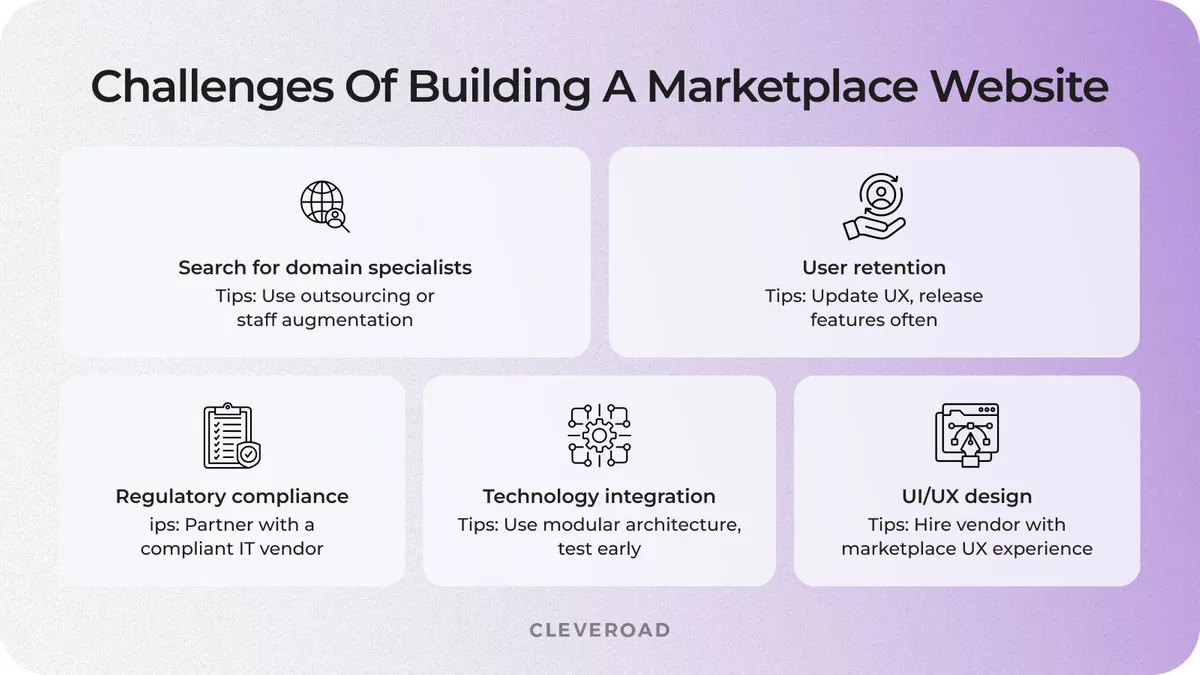
Challenges of building a marketplace website
Marketplace Website Development Expertise from Cleveroad
Building a robust and competitive marketplace platform requires profound expertise in such a domain. Cleveroad is a professional marketplace app development company located in Northern Europe. Our team has 13+ years of experience in delivering a wide variety of IT-related services and custom-built software solutions for e-commerce businesses. We are certified with ISO 9001 and ISO 27001 standards, which proves our commitment to quality management and information security across all project stages.
The Cleveroad team has impressive experience in marketplace building. We'll tell you about the latest e-commerce solutions from our portfolio.
Location-based marketplace for bars and pubs
Our team created a Location-Based Marketplace for Bars and Pubs. Our UK-based client wanted to get a cross-platform app to attract more customers by allowing them to buy a subscription for food and drink. So we created a flexible and holistic digital solution with a user-friendly design, integrated several payment options in it and developed an admin panel for the easier user management.
As a result, the customer received a fully functional location-based marketplace app that streamlined bar discovery, simplified subscription management, and boosted user retention. The admin panel allowed them to efficiently manage vendors, track usage metrics, and launch targeted promotions. The intuitive UX and flexible payment integration led to a strong user adoption from day one, helping the client scale the platform locally and prepare for further market expansion.
This is what Oliver Carew, the founder of El Tab app, says about cooperation with our Cleveroad team upon Location-based marketplace platform development:
Oliver Carew, Founder of El Tab. Feedback about cooperation with Cleveroad
Platform to book custom services
The Cleveroad team also developed a Marketplace for service providers for a client in Switzerland. The goal was to create a space where users could offer their services and seamlessly transition into self-employment. So, we implemented dual-role functionality, enabling users to switch between service provider and customer modes within a single profile. Additionally, we focused on building an intuitive interface with role-based UI states to ensure smooth user experiences for both vendors and clients.
The platform supports user onboarding, service listing, booking management, and secure payment integration, delivering a reliable foundation for running and scaling a service-based business.
As a result, the client received a fully functional, user-centric marketplace that empowered individuals to monetize their skills, scale service delivery, and manage bookings efficiently through a single, intuitive platform.
Business owners choose Cleveroad not just for our engineering expertise but for our ability to translate business goals into scalable marketplace platforms. We help companies validate ideas, define core features, and plan sustainable growth from day one. Our team builds custom marketplaces that balance fast time-to-market with long-term flexibility and performance. With proven delivery processes and ISO-certified quality standards, we ensure security, compliance, and product stability. Let’s discuss your marketplace vision and how we can bring it to life.
Work with an experienced marketplace web development partner
Contact us! Having successfully delivered marketplace projects, our ecommerce IT experts will help you build a robust marketplace to attract and engage a loyal user base for your ecommerce business
Let's talk more about the steps you need to take while developing an online marketplace. Here are the key steps to build your marketplace successfully:
- Define your niche & audience.
- Validate your marketplace idea.
- Choose your revenue model.
- Find out a budget approach.
- Partner with a reputable IT vendor.
- Think out the UI/UX design.
- Develop your marketplace
- Test and refine your marketplace.
While the exact cost of developing a marketplace depends on various factors, the range falls between $30,000 and $200,000+. Knowing how to build and planning to build a successful marketplace business are crucial to keeping costs within this range. Key cost-forming factors include features, complexity, and developer location.
To create a marketplace website with multi-vendor functionality, start by outlining your business logic and technical requirements. Since a marketplace is a type of ecommerce platform that connects multiple sellers with buyers, your solution must support features like vendor dashboards, inventory management, and commission settings. During the marketplace app development process, it’s critical to ensure that sellers can easily create an account, manage their listings, and track orders through a convenient marketplace mobile app or web interface.
A key marketplace feature is usability, both for vendors uploading products and for buyers browsing them. Whether you're building a paid or free marketplace, make sure onboarding is simple and frictionless. If you’re not sure where to begin, check out our guide to learn how to start and scale your platform. With the right tech partner, your interest can build into a profitable business with a flexible, scalable infrastructure tailored to your niche.
Even if you're questioned about how to build it yet, understanding how online marketplaces make money is a crucial first step. These platforms typically generate revenue through:
- Transaction fees, a percentage taken from each sale that occurs.
- Listing fees for sellers to feature their products
The best way to find someone to build an online marketplace is through software development outsourcing, which offers access to a global pool of skilled developers. This approach can significantly reduce the time to build your platform, ensuring a quicker launch. Outsourcing experts can help your marketplace project by incorporating best practices and innovative features through the custom software development services, and increasing the chances of building a profitable venture. By leveraging their expertise, you can enhance the success of your marketplace, whether it's a common marketplace revenue model or a niche marketplace for used goods.

Evgeniy Altynpara is a CTO and member of the Forbes Councils’ community of tech professionals. He is an expert in software development and technological entrepreneurship and has 10+years of experience in digital transformation consulting in Healthcare, FinTech, Supply Chain and Logistics
Give us your impressions about this article
Give us your impressions about this article
Comments
1 commentsVery Informative and creative contents. This concept is a good way to enhance the knowledge. thanks for sharing.Continue to share your knowledge through articles like these, and keep posting more blogs. And more Information how to build an online marketplace.
